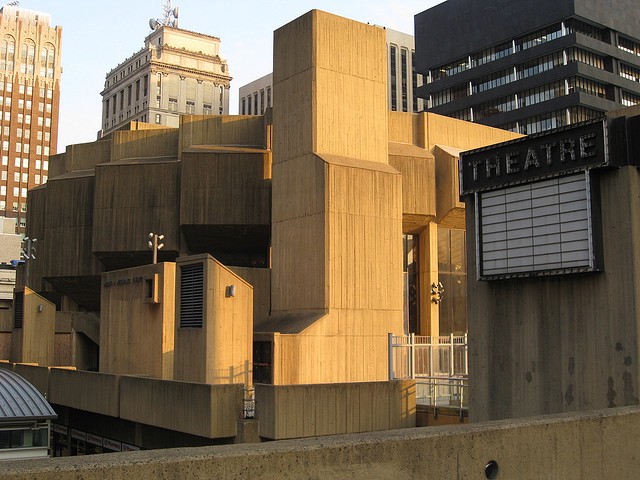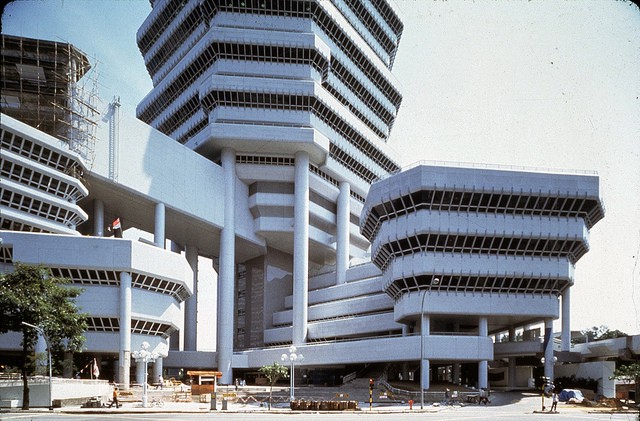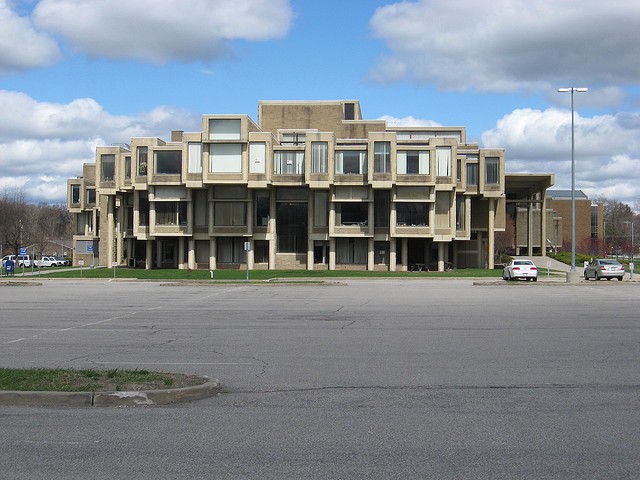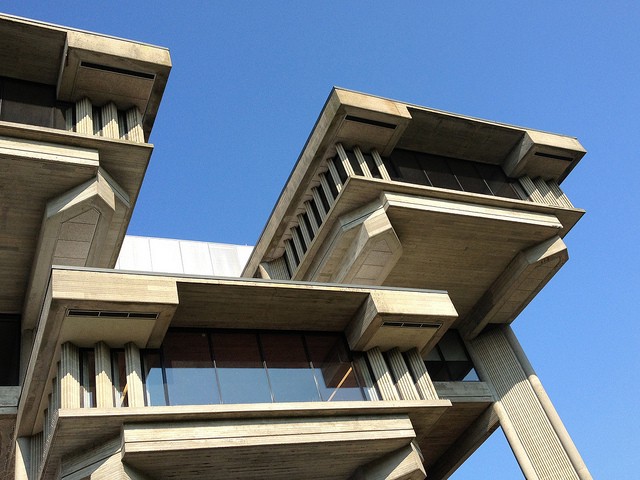Brutalism's Bullies
by Anthony Paletta

In late April, the city of Baltimore issued a certificate of demolition for the Morris A. Mechanic Theater, prevailing in a lengthy quest to destroy one of its most unique buildings. With a character somewhere between a stone-age helmet and a concrete cog, the nearly fifty-year-old building’s assertive structure has earned the affection of a small number of enthusiasts who embrace its almost oppressively functional style of architecture — and almost no one else. The theater, designed by the revered and often imperiled architect John Johansen, will be replaced by a condo.
The story of the Mechanic has become overly familiar. Brutalism, a muscular and monumental architectural style known for its unsparing use of cast concrete, has grown old enough since its heyday in the fifties, sixties, and seventies to have aged badly, but not old enough to inspire much sympathy. The austere, domineering artifacts of its philosophies now face widespread enmity; a number of institutions, with varying degrees of exertion, have sought in recent years to replace their Brutalist inheritances with practically anything else.
Of the five at-risk Brutalist buildings I wrote about being under threat two years ago, three of them are now gone, or about to be demolished. It’s been a bad year for Johansen in particular: In addition to the Morris A. Mechanic Theater, the delightful Mummers Theater in Oklahoma City faces imminent destruction, as soon as the proper certificate emerges from the city’s administrative process. The destruction of Bertrand Goldberg’s Prentice Women’s Hospital in Chicago began last fall, after such helpful developments as a Rahm Emanual Chicago Tribune op-ed hailing its replacement as progress. The Third Church of Christ Scientist, a Brutalist church in Washington, D.C., was demolished in March. Five of the buildings in Paul Rudolph’s Shoreline Apartments in Buffalo, New York, are due to be razed.
As John Grindrod wrote in the introduction to Concretopia: A Journey Around the Rebuilding of Postwar Britain:
There is an accepted narrative to the way we think about our postwar architectural legacy. That narrative is somewhat akin to the plot of a superhero blockbuster: a team of supervillains — planners, architects, academics — have had their corrupt, megalomaniac way with the country for 30 years. Then, at long last, a band of unlikely heroes — a ragbag of poets, environmentalists, and good, honest citizens — rise up against this architectural Goliath and topple it in the name of Prince Charles.”
This is, unfortunately, exactly how large numbers of critics conceive of Brutalism today. Those who wish to preserve examples of the the style aren’t simply fighting against indifference, they’re combating avowed foes — antagonists who would gladly take a turn at the wrecking ball — who view sympathy for the style as willful contrarianism of the “Bach or Before, Ives or After” variety, not just divorced from reasonable taste but purposefully set at odds with it. They sense that battle lines have remained neatly drawn between (lower-case) modernists and traditionalists, and that modernists are now making a convenient pivot to save their austere wonderlands — everyone becomes a fan of precedent once there’s a Supreme Court decision that they like. As Rod Dreher wrote in at The American Conservative: “It is ironic that Modernists, who based their entire movement on liberation from tradition, are in the position of making traditionalist(ish) arguments for saving their hideous buildings from the wrecking ball.”

The task of Brutalism preservation, like many others, has been to safeguard a dying species of architecture that isn’t coming around again. A Next American City piece speculated hopefully that “Prentice Hospital Could Become Modernism’s Penn Station Moment.” It hasn’t. Curiously though, as Brutalism perishes in the real world, it’s been flourishing in the publishing sphere. Paul Rudolph, a fascinating architect whose work has suffered from a broad spate of demolition, is receiving a handsome tribute in a forthcoming Yale University Press Volume, Timothy Rohan’s The Architecture of Paul Rudolph, while Chris Mottalini’s After You Left/They Took it Apart offered a tribute to Rudolph’s lost homes (a traveling exhibit on one of Rudolph’s lost Florida houses is also afoot). The heroic print-only architecture magazine Clog released a 2013 issue on Brutalism; Grindrod’s Concretopia and Owen Hatherley’sMilitant Modernism and A New Guide to the Ruins of Great Britain have issued forthright defenses of the lasting value and design quality of much Brutalist construction in the UK. Such developments, and the valiant work of local and national preservationists, seem to have secured a few successes: the landmarking of M. Paul Friedberg’s 1975 Peavey Plaza in Minneapolis and Marcel Breuer and Roebrt Gatje’s Broward County Main Library in Fort Lauderdale, as well as the salvation of Paul Rudolph’s Orange County Government Center. Now the focus of a renovation plan, the Orange County center is the subject of an unrelated and bizarre, if intriguing, proposal from prolific New York hotel designer Gene Kaufman to purchase it for some unspecified private use.
As deep as the Brutalism bad vibes run — in a 2012 New York Times Room for Debate piece on brutalism, Anthony Daniels screeched, “Atrocities Should be Eliminated” — profit, not bile, is generally the strongest threat to its longevity. Most developers’ formula for determining whether a building is dispensable or not is grounded in whether they own it and can build something larger on the site. This is a threat to any architecture, of course, but especially so to varieties that the larger public doesn’t instinctively value. If the Real Estate Board of New York could argue with a straight face that not a single structure in Manhattan’s Midtown East — mostly composed of venerable pre-war structures — merited landmarking, then what chance is there for Brutalism in Baltimore?

Fortunately, at times sheer presence has proven a valuable boon for some Brutalist structures. In the case of government and institutional structures, where physical demands for replacement structures typically aren’t radically different, demolition and new construction would routinely prove more expensive than renovation. This was the case with the Orange County Government Center, where the county government was skeptical that wholesale demolition and replacement would actually prove any cheaper than renovation. I wrote recently here about the immense size of American sporting facilities offering little guarantee of their survival; happily there’s no luxury-seating-level incentive to level Kallman and McKinnell’s immense Boston City Hall or Rudolph’s University of Massachusetts-Dartmouth.
The most substantial misfortune for Brutalist structures, though, is that they’re so frequently associated with urban decay. The United States doesn’t have nearly as substantial a residential stock of Brutalist buildings as in Europe, but what it does have — plenty of government, educational, and institutional structures — almost universally suffer from a lack of maintenance. The imagery of rundown Brutalist structures — like The Mechanic Theater and Mummers, each abandoned for a decade — is even worse in Europe, where they’re often identified with vast legacies of lower-income residential construction from the council estate to the banlieue to whatever dystopia you’d like to find.
It’s worth remembering that the breadth of midcentury modern design didn’t always enjoy its present relative vogue. Some pinnacles never aged — Mies Van Der Rohe and the Eames chair — but much modernism wasn’t given a second thought. As tiresome as it might be to cite Mad Men, and as inchoate as its influence on popular culture might be, it’s proven a useful means to see production design explicitly influenced by Skidmore Owings and Merrill’s nineteen sixties work presented as crisp and new — not as a patchwork renovation torn asunder by new ductwork or electric cables. Google “Mad Men” and architecture and you’ll see a wealth of items pointing to the broader second tier of modernism: Gordon Bunshaft and Wallace Harrison, Emery Roth and Sons, Charles Luckman, William Pereira, and others. It’s doubtful that we’re going to see a hit Brutalist TV series, but simple examples of Brutalist structures brought tastefully to the 21st century could prove a similar aid.
None of this is to deny that there are often real problems with many Brutalist structures. Their upkeep can prove considerably expensive due to design issues; the Orange County Government Center, for instance, has eighty-seven distinct roofs, while the Third Church of Christ Scientist required the costly deployment of considerable scaffolding to change a ceiling lightbulb. In many cases, Brutalist structures had downright terrible notions of how to arrange space and strangled urban life like a vintage seventies street villain. The main entrance of the Mechanic Theater, for instance, faced a mid-block plaza while largely ignoring Baltimore’s adjacent main thoroughfare. In some cases, buildings are arranged in ways that directly frustrate any meaningful efforts to build an engaging pedestrian sphere. That’s a pretty understandable reason for replacing them, though in some situations it’s not actually the case. Boston City Hall’s Plaza, for example, is not an insuperable condition of the building’s existence. Its totalitarian horror hasn’t crushed life in adjacent dense streets directly to the south. Rather, it’s the immense plaza that sucks the life out of the area; if you can fit Cirque du Soleil into your square with plenty of room to spare (as Boston’s been doing lately), it’s too big.

The humanizing touches in Brutalist structures — and in fairness many lacked them — have often been forgotten or removed. Timothy Rohan’s Paul Rudolph volume outlines a number of fanciful touches in Rudolph’s U. Mass Dartmouth volumes:
Carefully chosen, brightly colored textiles and carpeting acted as vibrant, stimulating foils to the omnipresent, gray concrete… [t]hey chose to upholster the common room banquettes in orange and carpet the floor with a pattern of orange, red, and purple stripes. The banded carpet echoed the raised ridges of the concrete block and the striations on the poured-in-place structural beams and balconies.
A similar spirit guided recent renovations of the library, infusing light, color, and openness to the space. Glass additions, which alter the original design, show how considerable variation and revival of existing Brutalist architecture is possible. Robert A. M. Stern charted a similar renovation of Rudolph’s Art and Architecture building at Yale. Another Brutalist theater, the Alley in Houston, is undergoing a substantial renovation, which will alter much of its interior, while leaving the exterior intact. At a Clog panel on Brutalism last year, John Johansen’s son noted that his father’s response to threats to the Mechanic Theater had been to mull over how it might be altered to accommodate contemporary criticisms (regrettably, it’s unclear what solutions Johansen might have envisioned; he died in 2012). Similar revivals have become common in the UK, which, while it boasts arguably many more decrepit examples of the form, also has more viable peaks. The Barbican Estate and its contents have undergone some very sharp renovations; the complex remains desirable. Erno Goldfinger’s Balfron Tower is undergoing a renovation which seems entirely likely to prove successful. Even larger complexes can prove open to transformation: The huge Park Hill Estate, a sort of Jacobs Ladder spread above Sheffield, has sprouted multicolored panels and scrubbed decades of neglect.
A Penn Station moment would be a great boon to Brutalism, but it remains abidingly unclear that there’s any martyr whose passing the world would notice, let alone mourn in large numbers. In the absence of such a moment, the greatest need for Brutalism is likely not buildings that die spectacularly but that simply live effectively.
Anthony Paletta is a writer living in Brooklyn. He has written for The Wall Street Journal, Metropolis, The Daily Beast, Bookforum, and The Millions on urban policy, historic preservation, cinema, literature, and board wargaming.
Photos by Adam Gerard, Kelvin Dickinson, Joseph, jessamyn west, respectively
Correction: This piece originally ascribed Boston City Hall to John Johansen; it was designed by Gerhard Kallmann and Michael McKinnell.
